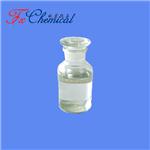The ionic liquid 1-butyl-3-methylimidazolium hexafluorophosphate ([Bmim][PF6]) has been much studied for CO2 removal. It was first used by Blanchard et al. 1999 to enhance the solubility of CO2. The PF6 anion is responsible for high CO2 solubility in an ionic liquid. [Bmim][PF6] has higher CO2 solubility than many ionic liquids such as 1-octyl-3-methylimidazolium tetrafluoroborate ([C8mim][BF4]), 1-Butyl-3-methylimidazolium thiocyanate [Bmim][SCN], 1,3-Dimethylimidazolium methylphosphonate [Dmim][MP], 1-Hexyl-3-methylimidazolium trifluoromethane-sulfonate [C6mim][TfO], 1-Butyl-3-methylimidazolium trifluoroacetate [C4mim][TFA], 1-Octyl-3-methyl-imidazolium tetrafluoroborate [Omim][BF4], 1-Ethyl-3-methylimidazolium tetrafluoroborate [Emim][BF4], etc[1].
1-Butyl-3-methylimidazolium hexafluorophosphate is an ionic liquid employed in many environmentally friendly reactions.
It can also be used as a medium for reactions such as:
- Ring-closing metathesis of diene and enyne substrates in the presence of a novel recyclable ruthenium carbene complex.
- Nickel(II)acetylacetonate catalyzed oxidation of aromatic aldehydes to the corresponding acids using dioxygen as the oxidant.
- Lipase-catalyzed enantioselective acylation of allylic alcohols.
- Allylation of aldehydes using tetraallylstannane to yield homoallylic alcohols.
those consisting of tetrafluoroborate, alkylsulfate, alkylsulfonate, carboxylate, or phosphate anions are hydrophilic and are completely dissolved in water. Dupont and coworkers first reported stable hydrophobic imidazolium salt, 1-butyl-3-methylimidazolium hexafluorophosphate ([C4mim][PF6]) in 1996. Since then, this salt has been used as a typical hydrophobic IL in many chemical reactions because its mixture with water forms a biphasic layer. Furthermore, this IL shows poor solubility in hexane or ether, which allows realization of an easy work-up process. However, [C4mim][PF6] was reported to be sensitive to the moisture at high temperature and produced hazardous hydrogen fluoride as it decomposed. Therefore, bis(trifluoromethanesulfonyl)amide (NTf2) salts are now recommended as the anion for preparing hydrophobic ILs.
1-Butyl-3-methylimidazolium hexafluorophosphate is an imidazolium-based, hydrophobic, room temperature ionic liquid (RTIL). It can be prepared by reacting 1-methylimidazole with chlorobutane. Gaseous hydrofluorocarbons (HFCs) such as fluoromethane, fluoroethane and 1,1,2,2-tetrafluoroethane are soluble in BMIMPF6.
81.89 g (1.0 mol) of 1-methylimidazole, 128.95 g (1.0 mol) of and 92.0 g (1.0 mol) of potassium hexafluorophosphate in a 500 ml three-necked round bottom flask with a reflux condenser at 80 °C for 12 h. 1-bromobutane De-ionized water (100 ml) was added and a bi-phase was formed. The immiscible ionic liquid layer was separated from the water phase with a separating funnel. The ionic liquid was washed with de-ionized water (2 × 50 ml) until the water phase did not react with 0.001 M aqueous silver nitrate (AgNO3). Diethyl ether(2 × 30ml) was added to the ionic liquid and separated in a separating funnel. The ionic liquid 1-Butyl-3-methylimidazolium hexafluorophosphate was dried in a vacuum for 2 h. A colourless liquid was obtained Yield (86 per cent). 1H NMRof the ionic liquid sample (300MHz, DMSO) contains peaks at δ: 9.05 (s, 1H-imidazole), 7.77 (s, 1H-imidazole), 7.65 (s, 1H-imidazole),4.16 (s, N–CH3), 3.8 (s, N–methyl), 1.8 (s, CH2), 1.30 (s, CH2), and 0.92(t, methyl).
[1] Shaukat Ali Mazari . “Prediction of thermo-physical properties of 1-Butyl-3-methylimidazolium hexafluorophosphate for CO2 capture using machine learning models.” Journal of Molecular Liquids 327 (2021): Article 114785.



